Applied Internet of Things to Analyze Vibration, Workpiece Roughness, and Tool Wear: Case Study of Successive Milling
Abstract
1. Introduction
2. Experimental System
2.1. Hardware Architecture
2.2. Software Architecture
2.3. System Integration
3. Materials and Methods
3.1. Experimental Materials and Tools
3.2. Mastercam Processing Path Planning
3.3. VMX App Design
3.4. Taguchi Methods Orthogonal Array Design
3.5. Automatic Successive Cutting with Optimized Parameters
3.6. Introducing Data into the Industrial Internet of Things
4. Results and Discussion
4.1. Taguchi Methods Experimental Results
Analysis of Variance
4.2. Successive Cutting with Optimized Parameters
- Initial Cutting Stage (1st to 20th cutting trials):
- 2.
- Mid-Cutting Stage (21st to 40th cutting trials):
- 3.
- Late Cutting Stage (41st to 57th cutting trials):
Industrial Internet of Things and Numerical Analysis of Vibration on CNC Machine Tool Spindle
4.3. Tool Change Parameter Setting and Successive Process Error Message Recording System
4.3.1. Tool Change Timing Parameter Setting
4.3.2. Human–Machine Interface of VMX Plateform
5. Conclusions
- The optimized cutting parameter combination acquired through the Taguchi Method experiments contains a spindle rotational speed of 4100 rpm, cutting output of each flute of 0.04 (mm/min), radial cutting depth of 20 %D (1.2 mm), and axial cutting depth of 1.0 mm;
- Under optimized cutting parameters, the surface roughness Ra 0.444 μm obtained in the milling, compared to the surface roughness 0.465 μm obtained in the milling under cutting parameters in the orthogonal array, improves the processing quality by 4.516%;
- Through Analysis of Variance, the cutting output of feed per tooth contribution is 64.18%, and the confidence level is 98%, while the radial cutting depth contribution is 25.34% and the confidence level is 91%. The cutting parameters of the cutting output of each flute and radial cutting depth are, therefore, adjusted to present more obvious effects on workpiece surface roughness;
- The Pearson correlation coefficient between vibration and surface roughness along the X-, Y-, and Z-axis during continuous milling is 0.972, 0.841, and 0.898. These results indicate a strong linear relationship between vibration and surface roughness generated during successive milling, respectively;
- In the successive automated cutting process, the IoT system would propose a tool change alert when the vibration speed on the X-, Y-, or Z-axis, respectively, reaches 0.363 mm/s, 0.605 mm/s, or 0.493 mm/s, to remind operators of tool change as soon as possible.
Author Contributions
Funding
Data Availability Statement
Acknowledgments
Conflicts of Interest
References
- Malik, P.K.; Sharma, R.; Singh, R.; Gehlot, A.; Satapathy, S.C.; Alnumay, W.S.; Pelusi, D.; Ghosh, U.; Nayak, J. Industrial Internet of Things and its Applications in Industry 4.0: State of The Art. Comput. Commun. 2021, 166, 125–139. [Google Scholar]
- Amanullah, M.A.; Habeeb, R.A.A.; Nasaruddin, F.H.; Gani, A.; Ahmed, E.; Nainar, A.S.M.; Akim, N.M.; Imran, M. Deep learning and big data technologies for IoT security. Comput. Commun. 2020, 151, 495–517. [Google Scholar] [CrossRef]
- Kebande, V.R. Industrial Internet of Things (IIOT) forensics: The forgotten concept in the race toward industry 4.0. Forensic Sci. Int. Rep. 2022, 5, 100257. [Google Scholar]
- Javaid, M.; Haleem, A.; Singh, R.P.; Rab, S.; Suman, R. Upgrading the manufacturing sector via applications of Industrial Internet of Things (IIoT). Sens. Int. 2021, 2, 110–119. [Google Scholar]
- Xu, Z.; Liu, W.; Huang, J.; Yang, C.; Lu, J.; Tan, H. Artificial intelligence for securing iot services in edge computing: A survey. Secur. Commun. Netw. 2020. [Google Scholar] [CrossRef]
- Mehmood, M.U.; Chun, D.; Zeeshan; Han, H.; Jeon, G.; Chen, K. A review of the applications of artificial intelligence and big data to buildings for energy-efficiency and a comfortable indoor living environment. Energy Build. 2019, 202, 109383. [Google Scholar] [CrossRef]
- Hirman, M.; Benesova, A.; Sima, K.; Steiner, F.; Tupa, J. Design Fabrication and Risk Assessment of IoT Unit for Products Manufactured in Industry 4.0 Factory. Procedia Manuf. 2020, 51, 1178–1183. [Google Scholar]
- Kibria, M.G.; Nguyen, K.; Villardi, G.P.; Zhao, O.; Ishizu, K.; Kojima, F. Big data analytics, machine learning, and artificial intelligence in next-generation wireless networks. IEEE Access 2018, 6, 32328–32338. [Google Scholar] [CrossRef]
- Cioffi, R.; Travaglioni, M.; Piscitelli, G.; Petrillo, A.; De Felice, F. Artificial intelligence and machine learning applications in smart production: Progress, trends, and directions. Sustainability 2020, 12, 492. [Google Scholar] [CrossRef]
- Sisinni, E.; Saifullah, A.; Han, S.; Jennehag, U.; Gidlund, M. Industrial Internet of Things: Challenges, Opportunities, and Directions. IEEE Trans. Ind. Inform. 2018, 14, 4724–4734. [Google Scholar] [CrossRef]
- Qazi, S.; Khawaja, B.A.; Farooq, Q.U. IoT-Equipped and AI-Enabled Next Generation Smart Agriculture: A Critical Review, Current Challenges and Future Trends. IEEE Access 2022, 10, 21219–21235. [Google Scholar] [CrossRef]
- Chen, C.; Li, Y.; Wang, Q.; Yang, X.; Wang, X.; Yang, L.T. An Intelligent Edge-Cloud Collaborative Framework for Communication Security in Distributed Cyber-Physical Systems. IEEE Netw. 2024, 38, 172–179. [Google Scholar] [CrossRef]
- Xu, H.; Yu, W.; Griffith, D.; Golmie, N. A Survey on Industrial Internet of Things: A Cyber-Physical Systems Perspective. IEEE Access 2018, 6, 78238–78259. [Google Scholar] [CrossRef] [PubMed]
- Borghesi, A.; Burrello, A.; Bartolini, A. ExaMon-X: A predictive maintenance framework for automatic monitoring in industrial ioT systems. IEEE Internet Things J. 2023, 10, 2995–3005. [Google Scholar] [CrossRef]
- Bhavani, G.; Sudha, V.N.; Raghuram, K.S.; Suresh, K.; Kumar, P.V. Taguchi Method to Enhance the Surface Roughness. AIP Conf. Proc. 2023, 2810, 140008. [Google Scholar] [CrossRef]
- Bhaskar Mutyalu, K.; Venkatrami Reddy, V.; Uma, S.; Maheswara Reddy, K.; Prasad, L. Effect of machining parameters on cutting forces during turning of EN 08, EN 36 & mild steel on high speed lathe by using Taguchi orthogonal array. Mater. Today Proc. 2023, 80, 2411–2415. [Google Scholar] [CrossRef]
- Bouhali, R.; Bendjeffal, H.; Chetioui, K.B.; Bousba, I. Multivariable optimization based on the Taguchi method to study the cutting conditions in aluminum turning. Int. J. Interact. Des. Manuf. 2024, 1–11. [Google Scholar] [CrossRef]
- Nguyen, V.; Altarazi, F.; Tran, T. Optimization of Process Parameters for Laser Cutting Process of Stainless Steel 304: A Comparative Analysis and Estimation with Taguchi Method and Response Surface Methodology. Math. Probl. Eng. 2022, 6677586. [Google Scholar] [CrossRef]
- Singh, M.; Garg, H.K.; Maharana, S.; Muniappan, A.; Loganathan, M.K.; Nguyen, T.V.T.; Vijayan, V. Design and Analysis of an Automobile Disc Brake Rotor by Using Hybrid Aluminium Metal Matrix Composite for High Reliability. J. Compos. Sci. 2023, 7, 244. [Google Scholar] [CrossRef]
- Singh, M.; Garg, H.K.; Maharana, S.; Yadav, A.; Singh, R.; Maharana, P.; Nguyen, T.V.T.; Yadav, S.; Loganathan, M.K. An Experimental Investigation on the Material Removal Rate and Surface Roughness of a Hybrid Aluminum Metal Matrix Composite (Al6061/SiC/Gr). Metals 2021, 11, 1449. [Google Scholar] [CrossRef]
- Ginting, A.; Nouari, M. Surface integrity of dry machined titanium alloys. Int. J. Mach. Tools Manuf. 2009, 49, 325–332. [Google Scholar] [CrossRef]
- Pereira, R.B.D.; Lauro, C.H.; Brandão, L.C.; Ferreira, J.R.; Davim, J.P. Tool wear in dry helical milling for hole-making in AISI H13 hardened steel. Int. J. Adv. Manuf. Technol. 2019, 101, 2425–2439. [Google Scholar] [CrossRef]
- Caggiano, A.; Improta, I.; Nele, L. Characterization of a New Dry Drill-Milling Process of Carbon Fiber Reinforced Polymer Laminates. Materials 2018, 11, 1470. [Google Scholar] [CrossRef] [PubMed]
- Dudzinski, D.; Devillez, A.; Moufki, A.; Larrouquère, D.; Zerrouki, V.; Vigneau, J. A review of developments towards dry and high-speed machining of Inconel 718 alloy. Int. J. Mach. Tools Manuf. 2004, 44, 439–456, ISSN 0890-6955. [Google Scholar] [CrossRef]
- Pimenov, D.Y.; da Silva, L.R.R.; Machado, A.R.; França, P.H.P.; Pintaude, G.; Unune, D.R.; Kuntoğlu, M.; Krolczyk, G.M. A comprehensive review of machinability of difficult-to-machine alloys with advanced lubricating and cooling techniques. Tribol. Int. 2024, 196, 109677, ISSN 0301-679X. [Google Scholar] [CrossRef]
- Tamil Selvan, M.; Somasundaram, M.; Raja Annamalai, A. Optimizing dry milling of stir-cast and heat-treated AZ80 magnesium alloy using multiple criteria optimization technique: An experimental study. Sci. Rep. 2024, 14, 25801. [Google Scholar] [CrossRef] [PubMed]
- Chen, C.-S.; Pan, P.Y. Industrial Internet of Things Applied to Automated Processing System. In Proceedings of the 20th Conference on Precision Machinery and Manufacturing Technology—PMMT 2022, Kenting, Taiwan, 19–21 May 2023; p. B005. [Google Scholar]
- Chen, C.-S.; Hsu, S.-C. The Relationship of Optimal Cutting Parameter and Surface Roughness in Dry Milling. In Proceedings of the 2024 IEEE 6th Eurasia Conference on IoT, Communication and Engineering (IEEE ECICE 2024), Yunlin, Taiwan, 15–17 November 2024; p. T240035. [Google Scholar]
- Yang, Y.; Dong, Z.; Meng, Y.; Shao, C. Data-Driven Intelligent 3D Surface Measurement in Smart Manufacturing: Review and Outlook. Machines 2021, 9, 13. [Google Scholar] [CrossRef]
- Tseng, L.-W.; Hu, T.-S.; Hu, Y.-C. A Smart Tool Holder Calibrated by Machine Learning for Measuring Cutting Force in Fine Turning and Its Application to the Specific Cutting Force of Low Carbon Steel S15C. Machines 2021, 9, 190. [Google Scholar] [CrossRef]
- Mattila, J.; Ala-Laurinaho, R.; Autiosalo, J.; Salminen, P.; Tammi, K. Using Digital Twin Documents to Control a Smart Factory: Simulation Approach with ROS, Gazebo, and Twinbase. Machines 2022, 10, 225. [Google Scholar] [CrossRef]
- Celent, L.; Bajić, D.; Jozić, S.; Mladineo, M. Hard Milling Process Based on Compressed Cold Air-Cooling Using Vortex Tube for Sustainable and Smart Manufacturing. Machines 2023, 11, 264. [Google Scholar] [CrossRef]
- Dani, S.; Rahman, A.; Jin, J.; Kulkarni, A. Cloud-Empowered Data-Centric Paradigm for Smart Manufacturing. Machines 2023, 11, 451. [Google Scholar] [CrossRef]
- Abdullahu, F.; Zhujani, F.; Todorov, G.; Kamberov, K. An Experimental Analysis of Taguchi-Based Gray Relational Analysis, Weighted Gray Relational Analysis, and Data Envelopment Analysis Ranking Method Multi-Criteria Decision-Making Approaches to Multiple-Quality Characteristic Optimization in the CNC Drilling Process. Processes 2024, 12, 1212. [Google Scholar] [CrossRef]
- G-TECH Instruments Incorporation, VimoNetX1 Instruction Manual. Available online: http://www.ktmeng.com/pdf/vimonet%20manual2.pdf (accessed on 19 March 2025).
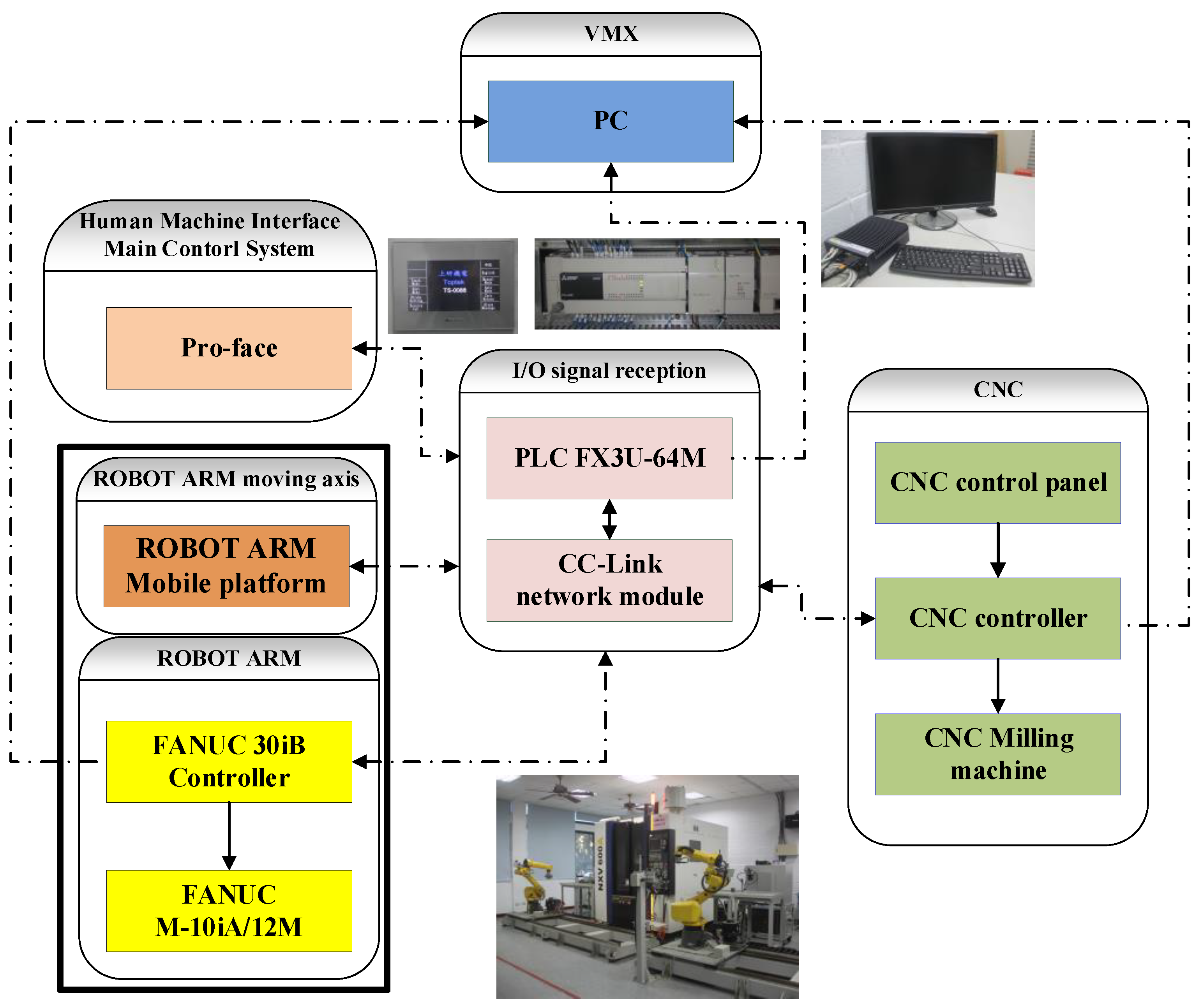
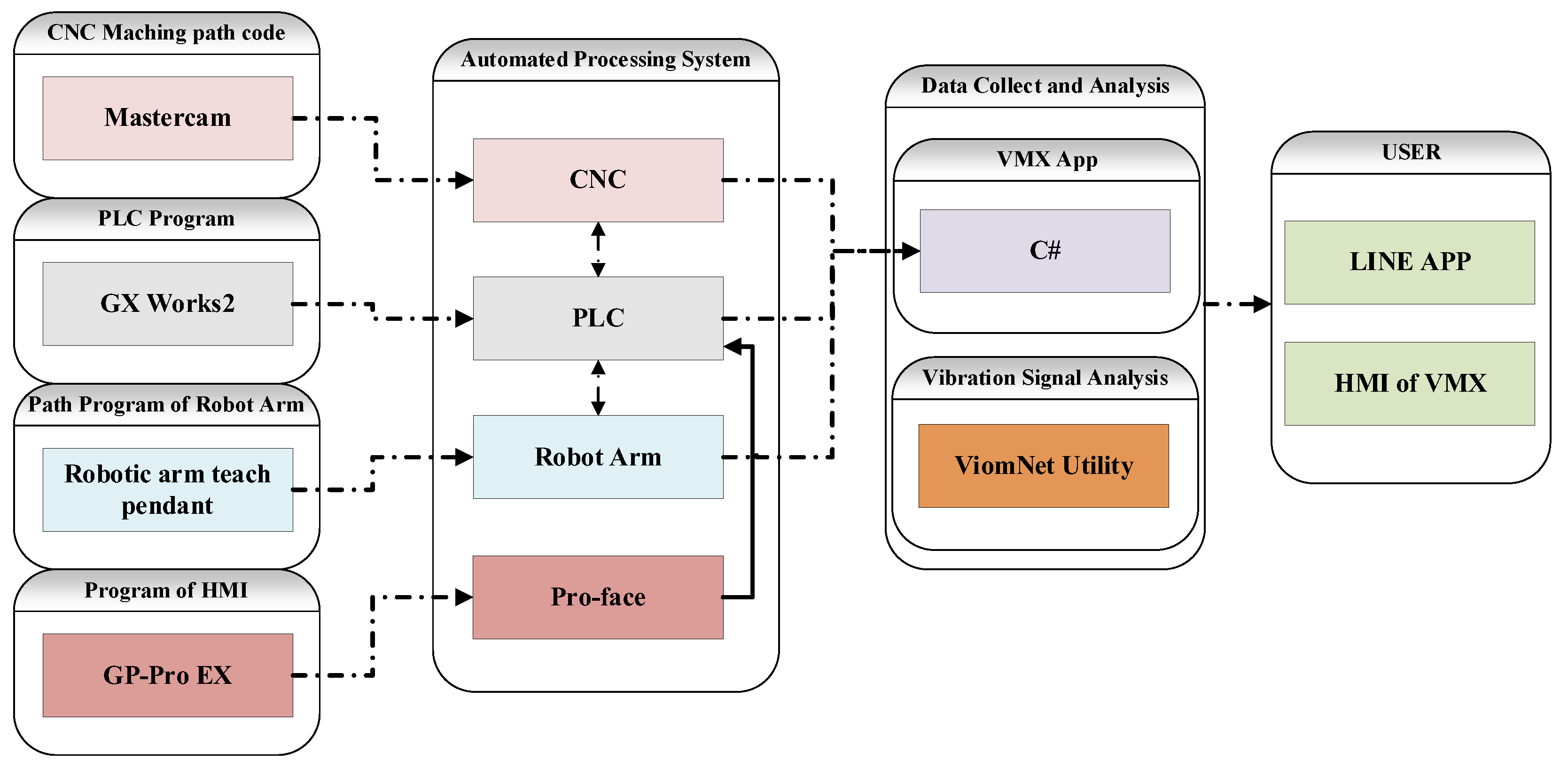


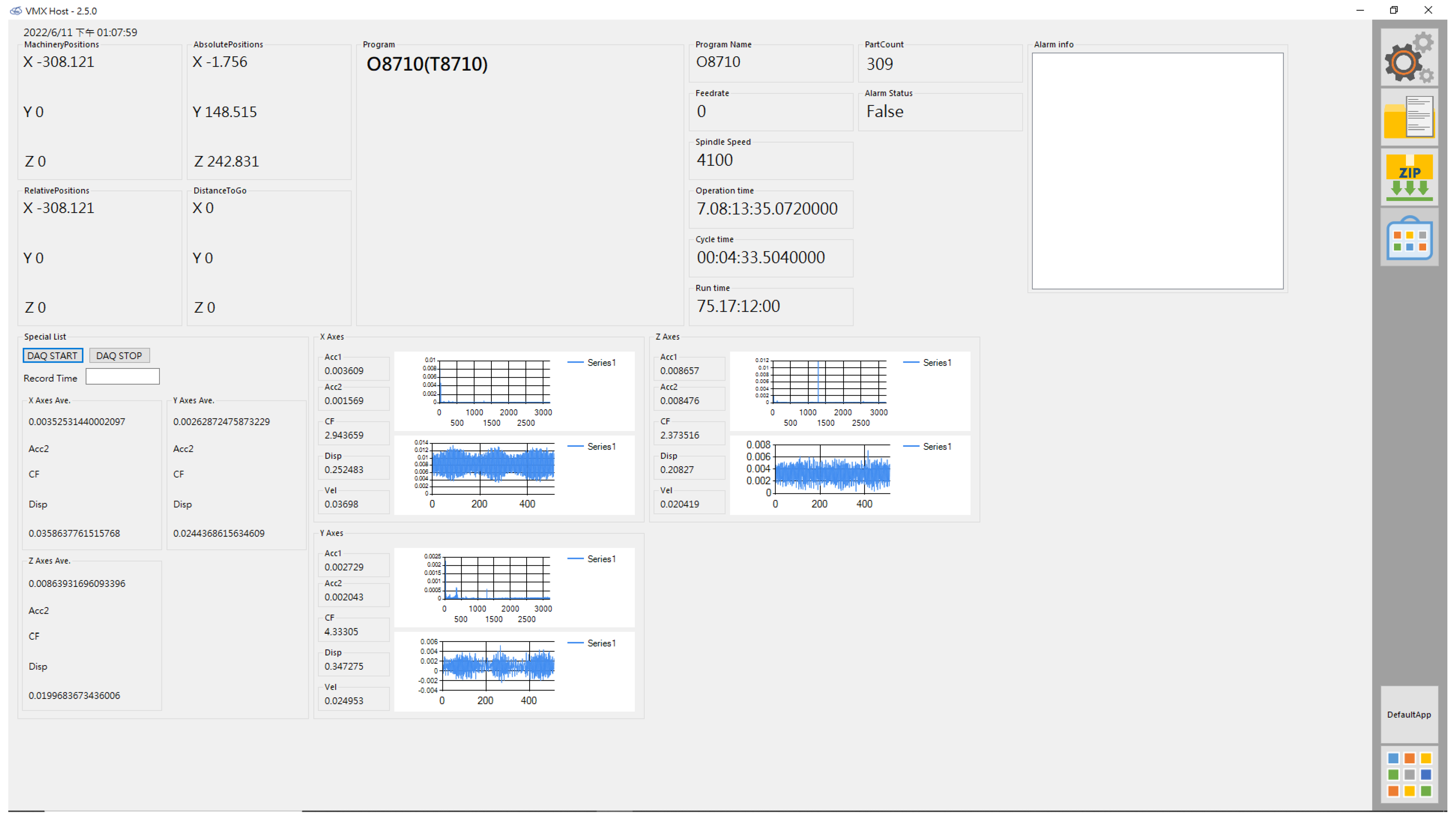
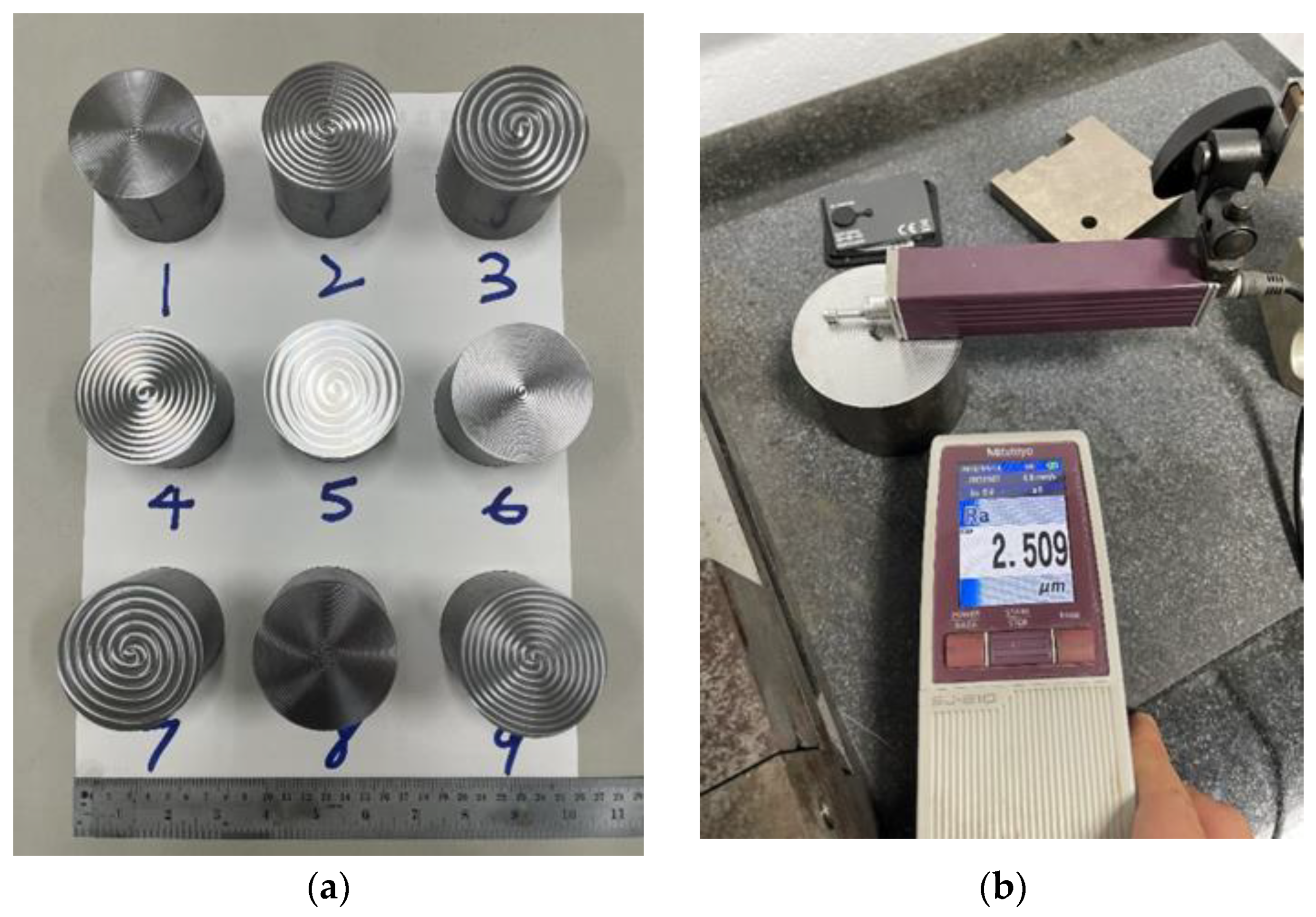






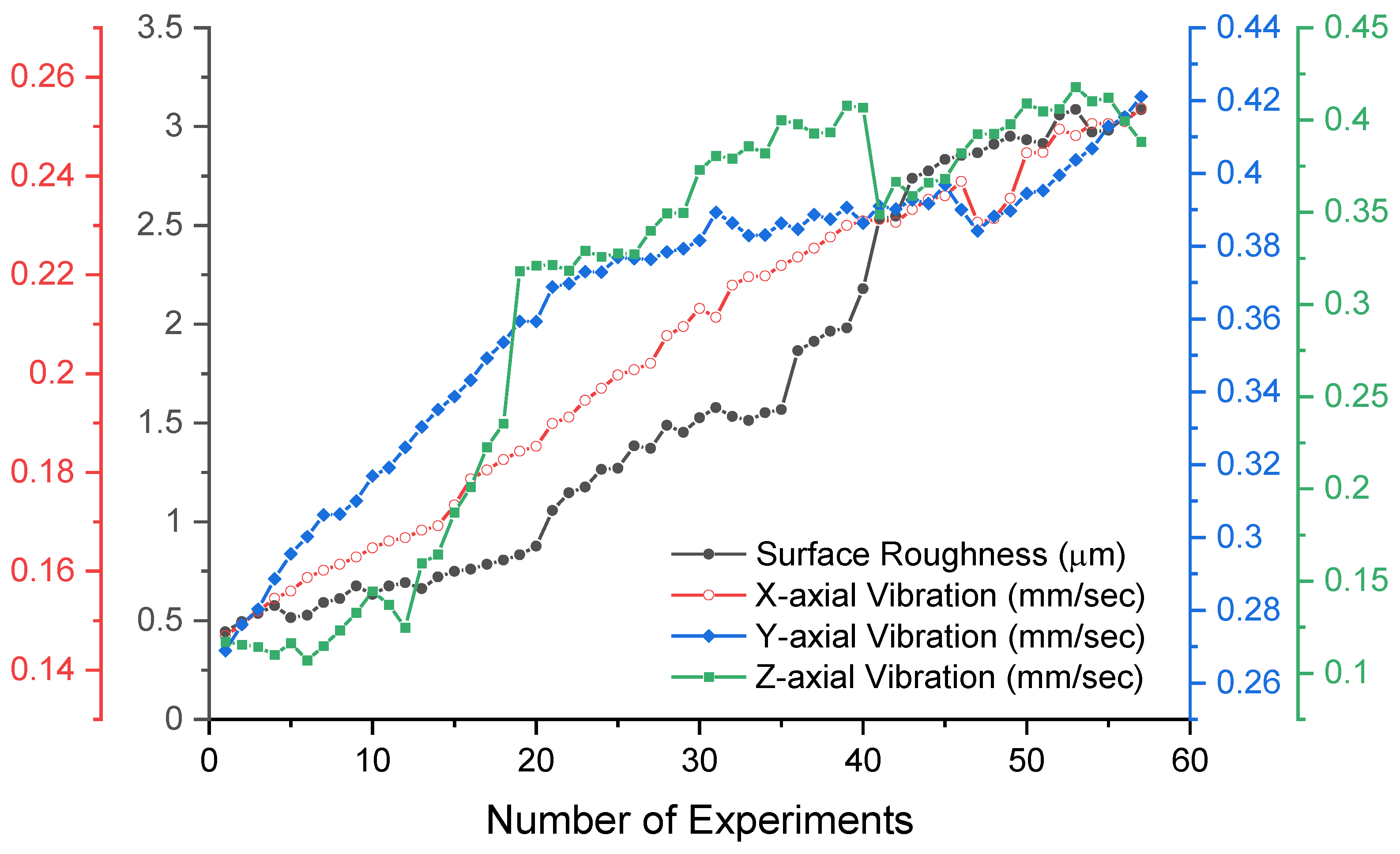

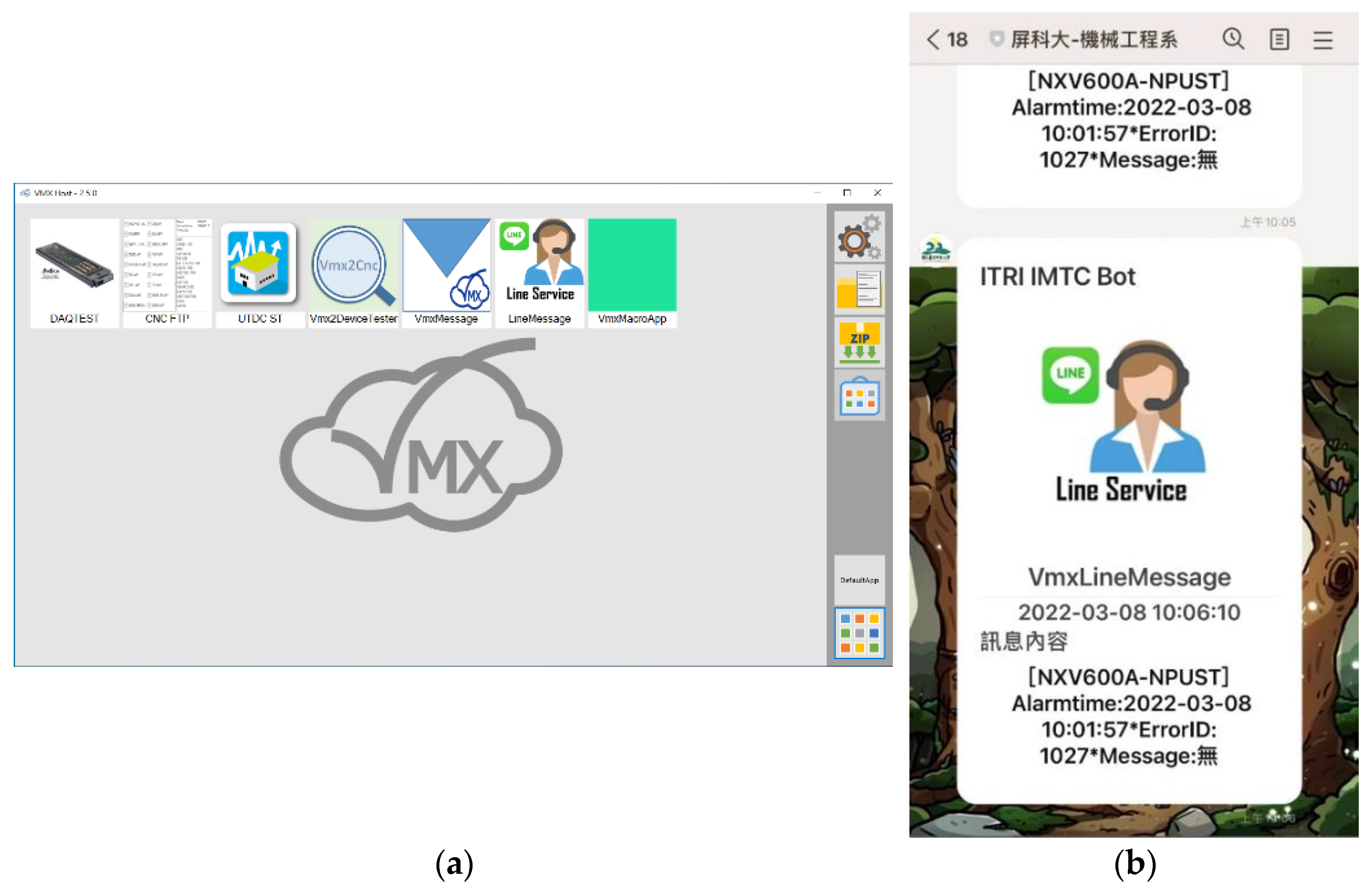
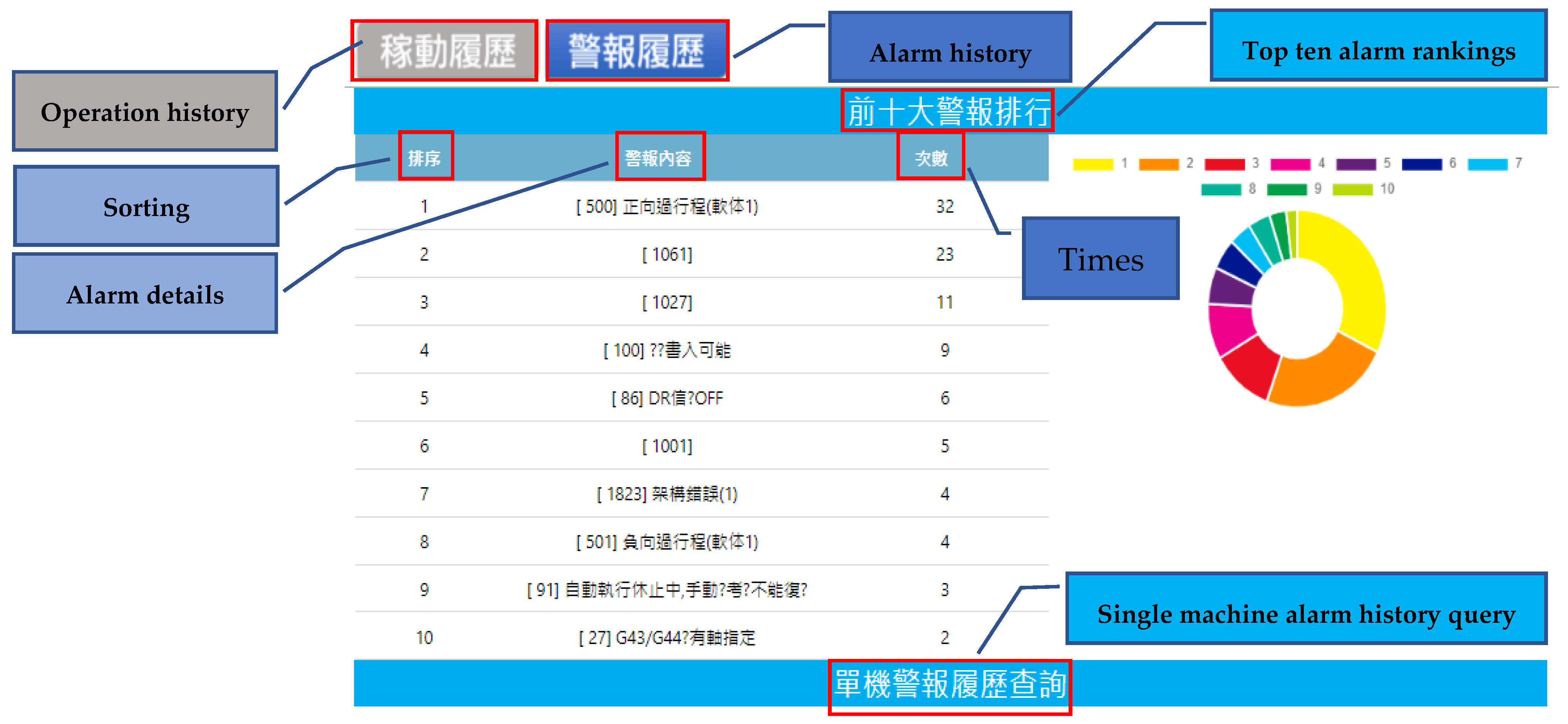
| Control Factors/Levels | L1 | L2 | L3 |
|---|---|---|---|
| S. spindle speed (rpm) | 3600 | 4100 | 4600 |
| F. feed for teeth (mm | 0.04 | 0.08 | 0.12 |
| R. radial cutting depth (mm) | 20% D | 50% D | 80% D |
| A. axial cutting depth (mm) | 1 | 1.5 | 2 |
| Experiment Run | Spindle Speed (rpm) | Feed for Teeth (mm) | Radial Cutting Depth (mm) | Axial Cutting Depth (mm) |
|---|---|---|---|---|
| Exp. 1 | 3600 | 0.04 | 20% D | 1 |
| Exp. 2 | 3600 | 0.08 | 50% D | 1.5 |
| Exp. 3 | 3600 | 0.12 | 80% D | 2 |
| Exp. 4 | 4100 | 0.04 | 50% D | 2 |
| Exp. 5 | 4100 | 0.08 | 80% D | 1 |
| Exp. 6 | 4100 | 0.12 | 20% D | 1.5 |
| Exp.7 | 4600 | 0.04 | 80% D | 1.5 |
| Exp. 8 | 4600 | 0.08 | 20% D | 3 |
| Exp. 9 | 4600 | 0.12 | 50% D | 1 |
| Experiment Run | Q1 (μm) | Q2 (μm) | Q3 (μm) | Ave. (Ra) (μm) | SD 1 | S/N |
|---|---|---|---|---|---|---|
| Exp. 1 | 0.601 | 0.383 | 0.398 | 0.460 | 0.122 | 6.08725 |
| Exp. 2 | 1.796 | 1.067 | 1.321 | 1.394 | 0.370 | −3.5366 |
| Exp. 3 | 3.059 | 1.581 | 1.392 | 2.010 | 0.311 | −4.8921 |
| Exp. 4 | 0.310 | 0.446 | 0.722 | 0.492 | 0.210 | 5.07263 |
| Exp. 5 | 1.681 | 0.862 | 0.871 | 1.138 | 0.470 | −2.1593 |
| Exp. 6 | 0.982 | 1.225 | 1.017 | 1.074 | 0.131 | −1.0416 |
| Exp. 7 | 1.308 | 0.545 | 0.575 | 0.809 | 0.432 | 0.39646 |
| Exp. 8 | 0.941 | 0.561 | 0.765 | 0.755 | 0.190 | 1.81497 |
| Exp. 9 | 1.019 | 1.322 | 1.145 | 1.162 | 0.152 | −1.7417 |
| Experiment Run | Spindle Speed (rpm) | Feed for Teeth (mm) | Radial Cutting Depth (mm) | Axial Cutting Depth (mm) |
|---|---|---|---|---|
| Level 1 | −0.47306 | 4.20384 | 2.63859 | 1.08046 |
| Level 2 | 0.97563 | −0.94190 | 0.28316 | −1.04218 |
| Level 3 | 0.50829 | −2.25106 | −1.91089 | 0.97258 |
| Effect | 1.44869 | 6.4549 | 4.54948 | 2.12264 |
| Rank | 4 | 1 | 2 | 3 |
Disclaimer/Publisher’s Note: The statements, opinions and data contained in all publications are solely those of the individual author(s) and contributor(s) and not of MDPI and/or the editor(s). MDPI and/or the editor(s) disclaim responsibility for any injury to people or property resulting from any ideas, methods, instructions or products referred to in the content. |
© 2025 by the authors. Licensee MDPI, Basel, Switzerland. This article is an open access article distributed under the terms and conditions of the Creative Commons Attribution (CC BY) license (https://creativecommons.org/licenses/by/4.0/).
Share and Cite
Chen, C.-S.; Pan, P.-Y. Applied Internet of Things to Analyze Vibration, Workpiece Roughness, and Tool Wear: Case Study of Successive Milling. Processes 2025, 13, 978. https://doi.org/10.3390/pr13040978
Chen C-S, Pan P-Y. Applied Internet of Things to Analyze Vibration, Workpiece Roughness, and Tool Wear: Case Study of Successive Milling. Processes. 2025; 13(4):978. https://doi.org/10.3390/pr13040978
Chicago/Turabian StyleChen, Chin-Shan, and Pin-Yu Pan. 2025. "Applied Internet of Things to Analyze Vibration, Workpiece Roughness, and Tool Wear: Case Study of Successive Milling" Processes 13, no. 4: 978. https://doi.org/10.3390/pr13040978
APA StyleChen, C.-S., & Pan, P.-Y. (2025). Applied Internet of Things to Analyze Vibration, Workpiece Roughness, and Tool Wear: Case Study of Successive Milling. Processes, 13(4), 978. https://doi.org/10.3390/pr13040978






